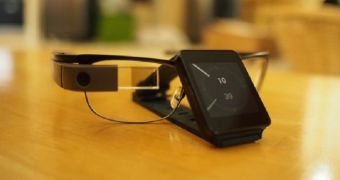The Google Glass is one wearable that started a lot of controversy, especially in the privacy department. Sure, the device sounds pretty neat and quite futuristic on paper.
All you have to do get things going is put the Glass on and say "OK Google." Like so, you get to do a bunch of stuff, from taking photographs to sending emails and finding answers to your questions. All of which is then available on display on Glass’ screen.
But the Glass also taps into a lot of human fears. For example, most people would feel uncomfortable knowing you are pointing a camera at them when you’re engaged in conversation or merely in the act of looking at them.
Back in April, a survey conducted by market-research firm Toluna found that 72% of Americans were refusing Google Glass due to privacy concerns. And they might have had a point there.
At some point, we talked about Sentiment Analysis, an app developed by San Diego-based company Emotient, which aims to be able to read people’s emotion based on facial expression decoding system. If that’s not eerie, we don’t know what is.
And if you’re willing to get over the crispiness, there’s always the pricing factor. Google Glass sells for a whopping $1,500 / €1,102 but once the novelty and the coolness factor of this gadget wares off, will you be left with much?
We’re trying to argue here that if you’re really in need of a wearable, you might as well choose to purchase an Android Wear smartwatch. Chances are you’ll love it more. And we’re going to give a few reasons we think this might be the case.
No one will frown upon a smartwatch
Google Glass has already been banned in British cinemas and some US counterparts, for fear Glass wearers might be tempted to pirate movies. But putting aside trying to record movies without permission, there’s that creepiness factor we’ve sketched above.
People will be freaked out only because it appears you’re pointing the camera at them. God forbid, they get the idea in their heads that you’re trying to read their emotions. Who would like that, really?
Walk into a room wearing a Glass, and everyone’s heads will be turned to you, voices will start whispering, while people will try to decipher the dark reason behind you wearing the Glass.
But no one will look at you strangely if you have a smartwatch on. Surely, if you take the Samsung Gear 2 instead of the beautiful, stylish Moto 360, and wear it at a wedding, some folks might launch at your fashion sense, but that’s it. You won’t be accused of trying to spy or trying to pirate anything.
Wearing a smartwatch is so much easier
The Glass is a head-mounted piece, end of story. No matter what you do, if you want to wear it, it will have to be where everybody can see it. Don’t be tempted to wear this expensive piece of gear around your neck or on top of your head as if they were sunglasses. It’s a bad, bad idea, as you never know what happens.
Not to mention, having a thick layer of Glass in front of your field of view might not appeal to everybody. On the other hand, the smartwatch rests on your arm, so it’s not that annoying, unless you overuse the strap. Sometimes you barely remember you have it on.
Smartwatches offer fast access to info Sure, both Android Wear and Google Glass offer the same word detection and voice recognition commands, but in some cases the wearable OS is far better.
But an Android Wear watch is always on, just waiting for you to command it to do something. But to get the Google Glass moving in the right direction, you’ll need to head flick up or pad touch. It might not be such a big deal in the end, but sometimes, if you forget to make the right moves, you’ll just end up talking in vain.
Smartwatches quickly and efficiently deal with notifications
Here comes the tricky part: the Glass requires handmade compatibility with each app, whereas Android Wear is automatically compatible with every app. You just download the application for your smartphone and, voila, you will receive notifications from it on your watch.
With the Glass, things don’t go that smoothly, but eventually Google will be porting this option to the Google Glass, but we still have time to wait until that happens.
Pricing
Last but not least comes the issues of pricing. Google can’t help to manage to make a main stream consumer product out of the Glass with a $1,500 / €1,100 price tag. Compared to the Glass, the so-called expensive smartwatches look dirt cheap. The LG G Watch sells for $229 / €168, while the Samsung Gear Live can be yours for $199 / €146.

 14 DAY TRIAL //
14 DAY TRIAL //